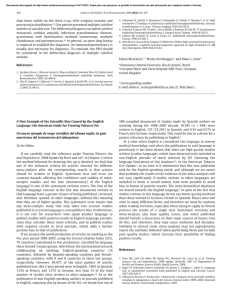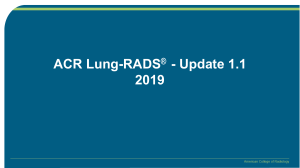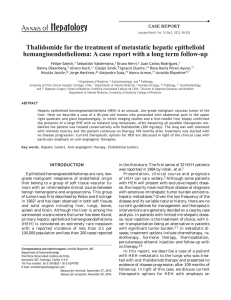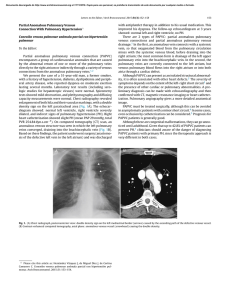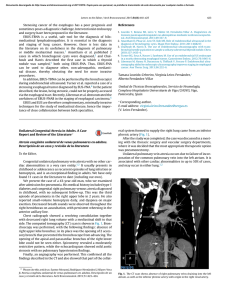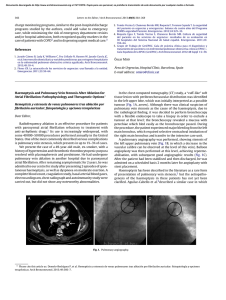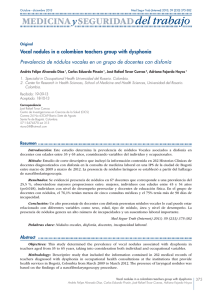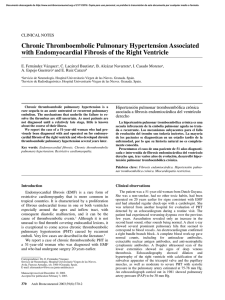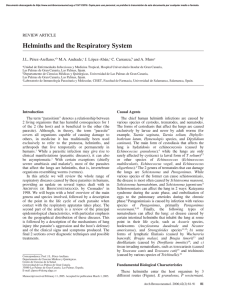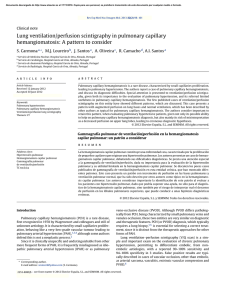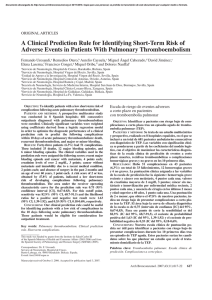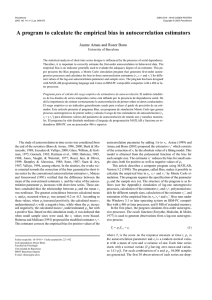Therefore, and as a result of Vázquez
Anuncio
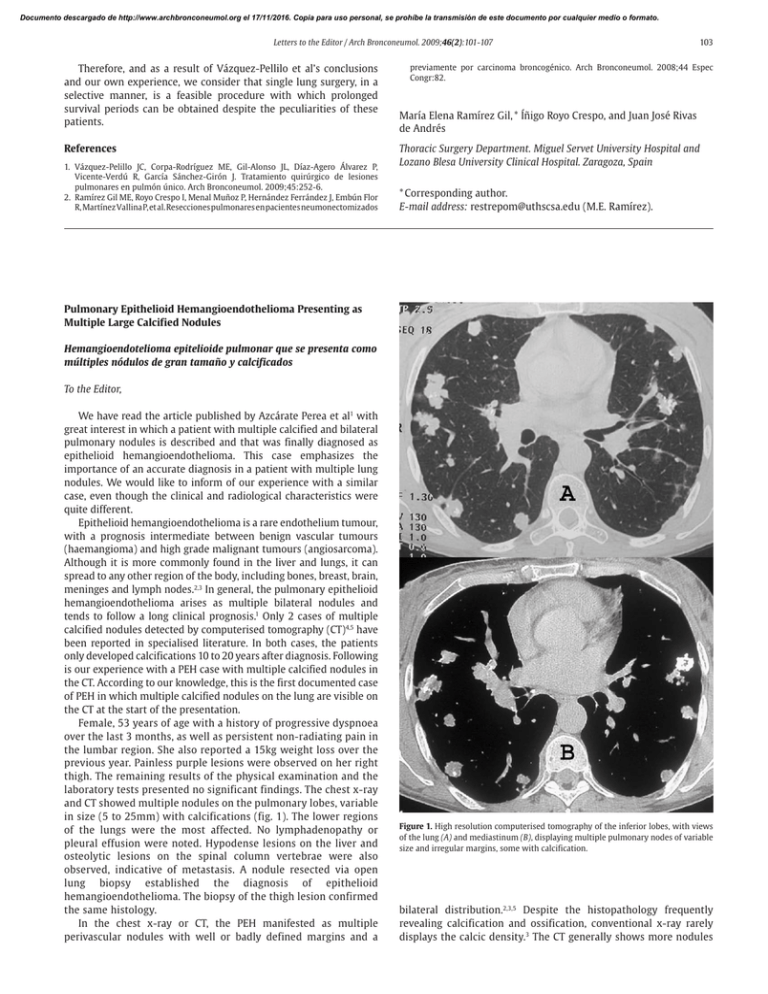
Documento descargado de http://www.archbronconeumol.org el 17/11/2016. Copia para uso personal, se prohíbe la transmisión de este documento por cualquier medio o formato. Letters to the Editor / Arch Bronconeumol. 2009;46(2):101-107 Therefore, and as a result of Vázquez-Pellilo et al’s conclusions and our own experience, we consider that single lung surgery, in a selective manner, is a feasible procedure with which prolonged survival periods can be obtained despite the peculiarities of these patients. References 1. Vázquez-Pelillo JC, Corpa-Rodríguez ME, Gil-Alonso JL, Díaz-Agero Álvarez P, Vicente-Verdú R, García Sánchez-Girón J. Tratamiento quirúrgico de lesiones pulmonares en pulmón único. Arch Bronconeumol. 2009;45:252-6. 2. Ramírez Gil ME, Royo Crespo I, Menal Muñoz P, Hernández Ferrández J, Embún Flor R, Martínez Vallina P, et al. Resecciones pulmonares en pacientes neumonectomizados 103 previamente por carcinoma broncogénico. Arch Bronconeumol. 2008;44 Espec Congr:82. María Elena Ramírez Gil, * Íñigo Royo Crespo, and Juan José Rivas de Andrés Thoracic Surgery Department. Miguel Servet University Hospital and Lozano Blesa University Clinical Hospital. Zaragoza, Spain * Corresponding author. E-mail address: restrepom@uthscsa.edu (M.E. Ramírez). Pulmonary Epithelioid Hemangioendothelioma Presenting as Multiple Large Calcified Nodules Hemangioendotelioma epitelioide pulmonar que se presenta como múltiples nódulos de gran tamaño y calcificados To the Editor, We have read the article published by Azcárate Perea et al1 with great interest in which a patient with multiple calcified and bilateral pulmonary nodules is described and that was finally diagnosed as epithelioid hemangioendothelioma. This case emphasizes the importance of an accurate diagnosis in a patient with multiple lung nodules. We would like to inform of our experience with a similar case, even though the clinical and radiological characteristics were quite different. Epithelioid hemangioendothelioma is a rare endothelium tumour, with a prognosis intermediate between benign vascular tumours (haemangioma) and high grade malignant tumours (angiosarcoma). Although it is more commonly found in the liver and lungs, it can spread to any other region of the body, including bones, breast, brain, meninges and lymph nodes.2,3 In general, the pulmonary epithelioid hemangioendothelioma arises as multiple bilateral nodules and tends to follow a long clinical prognosis.1 Only 2 cases of multiple calcified nodules detected by computerised tomography (CT)4,5 have been reported in specialised literature. In both cases, the patients only developed calcifications 10 to 20 years after diagnosis. Following is our experience with a PEH case with multiple calcified nodules in the CT. According to our knowledge, this is the first documented case of PEH in which multiple calcified nodules on the lung are visible on the CT at the start of the presentation. Female, 53 years of age with a history of progressive dyspnoea over the last 3 months, as well as persistent non-radiating pain in the lumbar region. She also reported a 15kg weight loss over the previous year. Painless purple lesions were observed on her right thigh. The remaining results of the physical examination and the laboratory tests presented no significant findings. The chest x-ray and CT showed multiple nodules on the pulmonary lobes, variable in size (5 to 25mm) with calcifications (fig. 1). The lower regions of the lungs were the most affected. No lymphadenopathy or pleural effusion were noted. Hypodense lesions on the liver and osteolytic lesions on the spinal column vertebrae were also observed, indicative of metastasis. A nodule resected via open lung biopsy established the diagnosis of epithelioid hemangioendothelioma. The biopsy of the thigh lesion confirmed the same histology. In the chest x-ray or CT, the PEH manifested as multiple perivascular nodules with well or badly defined margins and a Figure 1. High resolution computerised tomography of the inferior lobes, with views of the lung (A) and mediastinum (B), displaying multiple pulmonary nodes of variable size and irregular margins, some with calcification. bilateral distribution.2,3,5 Despite the histopathology frequently revealing calcification and ossification, conventional x-ray rarely displays the calcic density.3 The CT generally shows more nodules Documento descargado de http://www.archbronconeumol.org el 17/11/2016. Copia para uso personal, se prohíbe la transmisión de este documento por cualquier medio o formato. 104 Letters to the Editor / Arch Bronconeumol. 2009;46(2):101-107 than those visible on the chest x-ray, with irregular margins and perivascular distribution.2,3 Our patient presented multiple calcified nodules of variable size. The differential diagnosis included calcified metastasis, nodular amyloid, infectious granulomatous diseases, granulomas with hyalinisation, multiple hamartomas, multiple chondromas and pneumococcus.4,6 In general, an open lung biopsy is required to establish the diagnosis. An immunohistochemistry is usually also necessary for diagnosis.1 To conclude, the PEH should be considered in the differential diagnosis of multiple calcified nodules. References 3. Sakamoto N, Adachi S, Monzawa S, Hamanaka A, Takada Y, Hunada Y, et al. High resolution CT findings of pulmonary epithelioid hemangioendothelioma: unusual manifestations in 2 cases. J Thorac Imaging. 2005;20:236-8. 4. Luburich P, Ayuso MC, Picado C, Serra-Batllés J, Ramirez JF, Solé M. CT of pulmonary epithelioid hemangioendothelioma. J Comput Assist Tomogr. 1994;18:562-5. 5. Ledson MJ, Convery R, Carty A, Evans CC. Epithelioid haemangioendothelioma. Thorax. 1999;54:560-1. 6. Marchiori E, Souza AS Jr, Franquet T, Müller NL. Diffuse high-attenuation pulmonary abnormalities: a pattern-oriented diagnostic approach on high-resolution CT. AJR Am J Roentgenol. 2005;184:273-82. Edson Marchiori, a,* Bruno Hochhegger, a and Klaus L. Irion b Fluminense Federal University. Rio de Janeiro, Brazil Liverpool Heart and Chest Hospital-NHS Trust, Liverpool, United Kingdom a b 1. Azcárate Perea L, Oliveros Acebes E, Moreno Mata N, Salomón Pérez R, Vilalta Castel E, González Aragoneses F. Hemangioendotelioma epiteloide pulmonar. Arch Bronconeumol. 2009 ;45:466-8. 2. Díaz R, Segura A, Calderero V, Cervera I, Aparicio J, Jordá MV, et al. Central nervous system metastases of a pulmonary epitheloid haemangioendothelioma. Eur Respir J. 2004;23:483-6. A New Example of the Scientific Bias Caused by the English Language: the American Guide for Treating Tobacco Use Un nuevo ejemplo de sesgo científico del idioma inglés: la guía americana del tratamiento del tabaquismo To the Editor, If we carefully read the reference guide Treating Tobacco Use and Dependence: 2008 Update by Fiore and col1, in Chapter 1, where the method followed for drawing this up is detailed, we find that one of the inclusion criteria for articles selected for different meta-analysis after the corresponding search, is that articles should be written in English. Systematic bias and error are constant hazards affecting the confidence and validity of metaanalytic studies, and the bias (documentary) of the English language2 is one of the systematic revision errors. The bias of the English language consists in the fact that documents written in that language have a greater chance of being published, retrieved, and, therefore, quoted, in other languages, without this meaning that they are of higher quality. This systematic error means that any meta-analytic study that only takes into account studies published in a certain language is susceptible to bias. Furthermore, it is not rare for researchers who speak another language to publish studies with positive results in English-language journals, since they consider these more relevant, and to publish studies with negative results in local journals, which adds a further positive bias to that of publication. If we analyze the world production of articles on smoking in the five year period 1999-2003, using the Science Citation Index (SCI), 79 countries contributed to this production; classified by language these formed 3 major groups, which form the international network collaborating on smoking: English-speaking countries (14 countries), followed by Spanish-speaking countries and Frenchspeaking countries, with 9 and 8 countries in these last groups, respectively. However, 94.97% of the total number of articles published over this 5-year period were in English, 1.60% in Spanish, 1.51% in French, and 1.37% in German, less than 1% of the total number of studies were written in other languages.3,4 As to the publication of non-English-speaking authors in journals published in English, analysing this by means of the SCI, we found that out of * Corresponding author. E-mail address: restrepom@uthscsa.edu (E. Marchiori). 588 compiled documents of studies made by Spanish authors on smoking during the 1998–2007 decade, 76.19% (n = 448) were written in English, 137 (23.29%) in Spanish and 0.34 and 0.17% in French and German, respectively. This could be due to a desire for a greater relevance by publishing in English.5 At a time when English is considered the language to convey medical knowledge, and when the publication in said language is prioritized, it has been shown that there are high quality studies written in other languages, which have deserved to be included in non-English journals of merit selected by SCI (knowing the language limitations of this database6). In the American Tobacco Use Update1, at no time is it mentioned that this was published only for the English-speaking world, and although we are aware that probably the results of the evidence of the meta-analyses will not vary significantly if studies written in other languages are included in them, it would indeed, have been possible to avoid bias in favour of positive results. The main biomedical databases are biased towards the English language,6 in spite of the fact that studies written in this language do not use better quality methods than those written in German, French or Spanish. Biases exist and arise in many different forms, and therefore we must be cautious when reading revisions, especially when trying to apply in clinical practice the results of a single trial. Systematic revisions and meta-analyses also have quality issues, and when published should include a discussion on their main sources of biases. Few do this, and therefore, they may cause confusion and mistakes. Similarly to clinical trials, meta-analyses may not appropriately report the methods followed when performing them and include poor quality studies, which increase their possibility of finding positive results. References 1. Fiore MC, Jaén CR, Baker TB, Bailey WC, Benowitz NL, Curry SJ, et al. Treating tobacco use and dependence: 2008 update. Rockville, MD: US Department of Health and Human Services Public Health Service; 2008. 2. Egger M, Zellweger-Zähner, Schneider M, Junker C, Lengeler C, Antes G. Language bias in randomised controlled trials published in English and German. Lancet. 1997;350:326-9. 3. Villanueva Serrano S. Producción, colaboración e impacto de la actividad científica mundial en tabaquismo a través del Science Citation Index (1999–2003) [doctoral thesis]. Madrid: Universidad Complutense; 2007.
